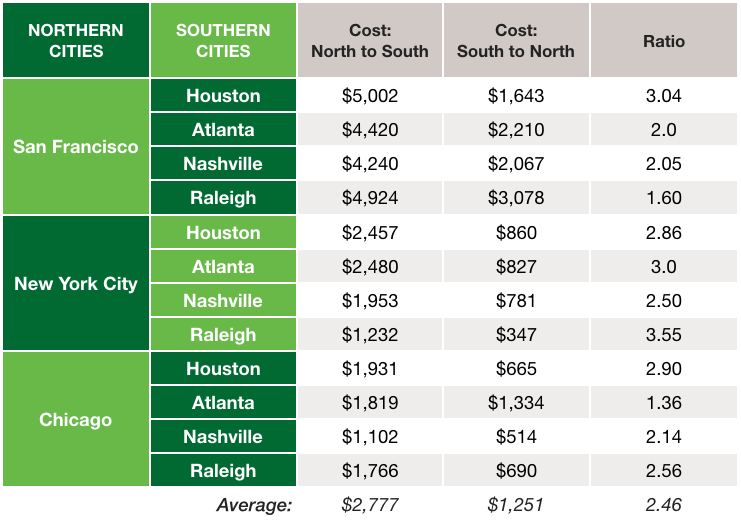Southern Urbanism's "U-Haul Index"
Two-way pair moving cost data reaffirms the explosive growth of Southern cities
Written By Satchel Walton
When people in the U.S. are looking to relocate, they typically have a lot of stuff to move. Some have figured out how to exploit this fact to get a live pulse on the direction of domestic migration. And the trend is clear: People are moving to the South.
The “U-Haul Growth Index,” makes use of the company’s internal data, and it clearly indicates that Southern metros are posting strong growth, while the biggest, most expensive cities of the North and California are declining. The trend shouldn’t come as a surprise to anyone who has been paying attention to the recent demographic shifts. The South has been growing faster than the Northeast and Midwest for around fifty years.
While U-Haul’s data is proprietary, we conducted a much simpler mid-year metric by directly comparing the rental prices between cities. We call it the MOVES Index (Mid-year Observations on Vigorous Emigration Southward). For instance, it’s possible to estimate the cost of renting a U-Haul from Philadelphia to Miami and then compare those numbers with a reverse trip. This allows us to see where higher demand exists across markets. The prices will only be the same if an equal number of people want to go both ways. Otherwise, U-Hauls would start to pile up in the city everyone wants to move to, and the trucks would never go back to the places those people want to move away from. For all intents and purposes, whichever direction of movement has a higher price for a U-Haul rental is the way more people want to go.
So, where do people want to go today? Check out these figures calculated on September 15, 2022:
On average, it costs $1,251 to rent a U-Haul going from Houston, Atlanta, Nashville, or Raleigh to New York, San Francisco, or Chicago. But a U-Haul going to one of the Southern cities will set you back $2,777. Going from Houston to San Francisco will cost you $1,643—from San Francisco to Houston, $5,002.
There are a variety of causes here: People like warmer weather (or, perhaps erroneously, think that they do). U.S. manufacturing began moving from the Rust Belt to the south in the 1950s—a shift that continues today. And the cost of housing is substantially lower in the South than in New York City or San Francisco. With the pandemic allowing more white-collar workers from those areas able to work from home, moving somewhere where they can afford a home office becomes an attractive option.
It’s important not to generalize too much. Looking at the 2020 census, areas around Minneapolis, Indianapolis, and Columbus, Ohio, have posted a lot more growth than those around Memphis, New Orleans, or Jackson, Mississippi. Much of the rural South continues to lose population. The Southern boom is a real trend, but it is heavily concentrated in the major metro areas of Florida and Texas as well as around Atlanta, Nashville, Raleigh-Durham, and Charlotte.
Interestingly, this shift to the South is undermining the region’s competitive advantage in housing costs. Southern metros continue to construct housing at a faster rate than their Northern counterparts, though not fast enough to keep up with growth. But as long as Southern cities are building housing faster than their more expensive competitors, expect the U-Hauls to keep driving South.
Satchel Walton is the Mencken Publishing Fellow on Urban Development.


